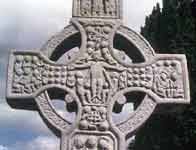6 March 1152: The Synod of Kells/Ceannas Mór was concluded on this day. This great gathering of the churchmen of Ireland was presided over by the Papal Legate Cardinal Paparoni, sent by Pope Eugene III to conduct the proceedings. On his first attempt to get to Ireland, in 1150, Paparoni was refused a safe conduct through England by King Stephen unless he pledged himself to do nothing in Ireland that would injure England’s interests there. The cardinal refused and returned indignantly to Rome. It would seem that this was an attempt by Stephen to prevent Paparoni from bringing papal confirmation for an arrangement in Ireland that would see Canterbury’s [the seat of the Church in England] claims in Ireland finally extinguished. The Irish though sent a fresh delegation to Rome and Paparoni was induced to return but this time via Scotland under the protection of King David.
He was accompanied by Gilla Crist Ua Connairche, first abbot of Mellifont, now bishop of Lismore and permanent papal legate in Ireland (he had been a fellow monk with the current pope, Eugenius III, at Clairvaux), who may have been one of the delegation who had been sent to Rome. The cardinal arrived in Ireland at some time in October of 1151. Apart from a week he spent in Armagh, very little is known about his activities before the convening of the synod in the following March; approximately four months of his time is, therefore, unaccounted for. It is probable that he visited church leaders and lay magnates in preparation for the synod; perhaps he needed to check that the general agreement claimed for the new diocesan arrangement existed.
The purpose of the Synod was to continue the Reform of the Irish Church begun at the Synod of Rathbrassill that was held in 1111 AD. These changes followed closely the reforms that were underway on the Continent. In Ireland the most visible aspect was the reorganisation of the Church along clearly set out strict Diocesan lines with a Bishop or Archbishop having a defined territory of jurisdiction.
This synod approved the consecration of four archbishops, where before there had been two. Ireland was divided into thirty-six sees, and four metropolitan sees: Armagh, Cashel, Tuam, and Dublin. Armagh was granted Primacy. The diocese of Dublin, ruled by the Ostmen (Danes), seceded from Canterbury and was united with Glendalough.
Turlough O'Connor/Tairrdelbach Ua Conchobair, the High King of Ireland, approved the decrees, and the pallia (cloaks of office) were conferred by the Papal Legate Cardinal Giovanni Paparoni. This territorial structure of ecclesiastical governance has continued down to the present day and in its basic form is the template still used by both the Catholic and Anglican Churches in Ireland.
There has been some confusion as to the actual location of this synod. The Annals of the Four Masters say Drogheda, but the 17th Century Historian Geoffrey Keating, quoting an old book that is no longer extant, gave Kells as the location. It is probable that there were two separate sessions of this synod. The first was held at Kells and concluded by March 6; it then reconvened at Mellifont, near Drogheda, around Sunday, March 9, and concluded on Palm Sunday (March 23). It is not known how the business of the synod was divided between the two sessions, but it is likely that episcopal consecrations took place later at Mellifont and that the four pallia were then distributed to the archbishops at the last sitting on Palm Sunday.


No comments:
Post a Comment